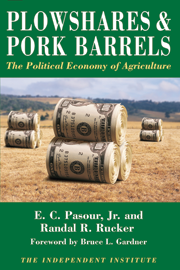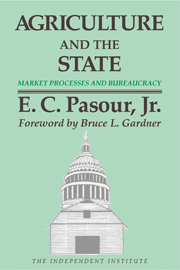With the 2007 farm bill temporarily stalled in the Senate, this is a good time to reconsider America’s schizophrenic agriculture programs and how they often work at cross-purposes.
Consider government subsidies. Under the current farm bill, enacted in 2002, government payments to farmers averaged about $17.5 billion annually from 2003 to 2006. The House-passed 2007 farm bill would cost an additional $286 billion over five years, including both direct payments and other provisions.
Politicians claim to be friends of the small “family farmer” but most government payments go to large farms. Half of all U.S. farms receive nothing at all because they don’t grow corn, wheat, cotton and other major crops that qualify for commodity payments.
Because most payments are based on a farm’s past production history, they likely have little effect on current commodity prices. But they do cause land prices to be bid up, meaning those who own the most land receive the most benefits.
Escalating land prices, in turn, raise the cost of entry into farming, hurting the little guy again. The government responds by offering subsidized farm credit, which provides $3 billion annually in ownership and operating loans to farmers and ranchers who don’t qualify for private loans. These subsidies increase the profitability of farming. This, in turn, encourages more production and results in lower crop and livestock prices.
The government’s involvement in risk management also helps decrease prices. For example, farmers are encouraged to purchase government-subsidized crop insurance, which cost taxpayers $4 billion annually. But many farmers are reluctant to purchase crop insurance because Congress usually can be counted on to provide ad hoc relief when droughts, freezes, floods and other weather-related problems occur.
So why buy insurance? Such ad hoc spending totaled more than $35 billion over the past decade.
Like the loan programs, the subsidized crop insurance and ad hoc disaster relief also increase the profitability of farming, encourage more production and result in reduced prices—as do the government’s agricultural research and extension programs.
While subsidized credit, crop insurance, ad hoc relief measures and research and extension programs stimulate output and retard prices, other government programs push prices up.
For example, the food stamp program, subsidized school breakfast and lunch programs and the Women, Infants and Children program all increase demand for agricultural products. Increased demand pushes prices higher. These programs cost taxpayers more than $50 billion in 2006.
Export subsidies, which cost taxpayers an additional $4 billion per year, also drive up prices. Much of the political support for the Food for Peace foreign aid program, for example, is based on the fact that it increases overseas demand for U.S. farm products.
Increased demand causes higher prices.
Over the years, the government also has raised farm prices with programs to take land out of production. The current Conservation Reserve Program, which costs taxpayers $2 billion a year, removes environmentally sensitive land from agricultural production and keeps it under long-term resource-conserving “cover.”
But other programs work at cross-purposes: in this case, an organic certification “cost share” program that provides financial assistance to organic crop and livestock producers. Because organic yields are lower, increases in organic agriculture bring more land into production, reducing wildlife habitat and partly offsetting the effects of CRP.
The dairy and sugar programs deserve special attention, raising the prices of milk and sugar while the government, through the food stamp and other subsidy programs, subsidizes the purchase of milk and sugar and products containing these ingredients.
You don’t have to be agricultural economists to realize that none of this makes sense. It’s time for a new approach.










